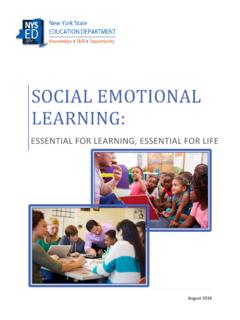Transcription of The link between pupil health and wellbeing and ... - GOV.UK
1 Protecting and improving the nation s healthNovember 2014 The link between pupil health and wellbeing and attainmentA briefing for head teachers, governors and staff in education settingsThe link between pupil health and wellbeing and attainment2 About Public health EnglandPublic health England exists to protect and improve the nation s health and wellbeing , and reduce health inequalities. It does this through world-class science, knowledge and intelligence, advocacy, partnerships and the delivery of specialist public health services. PHE is an operationally autonomous executive agency of the Department of health EnglandWellington House 133-155 Waterloo RoadLondon SE1 8 UGTel: 020 7654 Twitter: @PHEukFacebook: This briefing was written for PHE by Professor Fiona Brooks, head of adolescent and child health research, University of Hertfordshire, UK. Crown copyright 2014 You may re-use this information (excluding logos) free of charge in any format or medium, under the terms of the Open Government Licence To view this licence, visit OGL or email Where we have identified any third party copyright information you will need to obtain permission from the copyright holders concerned.
2 Any enquiries regarding this publication should be sent to Published November 2014 PHE publications gateway number: 2014491 The link between pupil health and wellbeing and attainment3 ContentsAbout Public health England 2 Key messages 4 Introduction 5 Learning social and emotional skills can have a positive impact on pupil attainment 6 school culture, ethos and environment affects wellbeing and attainment 7 Positive health behaviour and attainment 8 Links with the Ofsted inspection framework 9 The whole school approach 10 Resources 11 References 12 The link between pupil health and wellbeing and attainment4 The link between pupil health and wellbeing and attainmentKey messagesResearch evidence shows that education and health are closely ,2 So promoting the health and wellbeing of pupils and students within schools and colleges has the potential to improve their educational outcomes and their health and wellbeing outcomes.
3 This briefing draws on a rapid review approach that provides a broad, succinct scope of the scientific evidence. The complexity of the interrelationships between outcomes makes it difficult to draw firm conclusions about causality. However, this briefing offers head teachers, governors and school staff a summary of the key evidence that highlights the link between health and wellbeing and educational attainment. It underlines the value for schools of promoting health and wellbeing as an integral part of a school effectiveness strategy, and highlights the important contribution of a whole - school points from the evidence1. Pupils with better health and wellbeing are likely to achieve better Effective social and emotional competencies are associated with greater health and wellbeing , and better achievement. 3. The culture, ethos and environment of a school influences the health and wellbeing of pupils and their readiness to learn.
4 4. A positive association exists between academic attainment and physical activity levels of pupils. The link between pupil health and wellbeing and attainment5 IntroductionMaintained schools have statutory duties to promote children and young people s wellbeing3 and statutory responsibilities to provide a curriculum that is broadly based, balanced and meets the needs of all pupils. Under section 78 of the Education Act 2002 and the Academies Act 2010 such a curriculum must: promote the spiritual, moral, cultural, mental and physical development of pupils at the school and of society, and prepare pupils at the school for the opportunities, responsibilities and experiences of later life. 4,5 Children s wellbeing is influenced by a range of factors and includes their subjective feelings as well as social, physical and psychological aspects of their Consequently schools are key places for shaping general wellbeing .
5 The health and wellbeing of children and young people contributes to their ability to benefit from good quality teaching and to achieve their full academic A report on our children s health by the chief medical officer of England highlighted that: promoting physical and mental health in schools creates a virtuous circle reinforcing children s attainment and achievement that in turn improves their wellbeing , enabling children to thrive and achieve their full potential. 8 Academic success has a strong positive impact on children s subjective sense of how good they feel their lives are (life satisfaction) and is linked to higher levels of wellbeing in In turn children s overall level of wellbeing impacts on their behaviour and engagement in school and their ability to acquire academic competence in the first evidence successfully attaining GCSEs (five or more A*-C) is strongly associated with higher levels of life satisfaction among young people10 a UK study published by the Department for Education (DfE)7 found that pupil wellbeing predicted their later academic progression and engagement in school .
6 For example, pupils with better emotional wellbeing at age seven had a value-added key stage 2 score points higher (equivalent to more than one term s progress) than pupils with poorer emotional wellbeing DfE research also found that pupils with better attention skills also make more progress across the four key stages. For example, pupils with no attention problems at age 13 had a total value-added GCSE score that was equivalent to more than one extra GCSE at grade A* ( points higher)7 a systematic review of coordinated school health programmes (that promote health through explicit teaching in the curriculum and broader work to promote a healthier school environment) suggests positive effects on attainment11 The health and wellbeing of children and young people contributes to their ability to benefit from good quality teaching and to achieve their full academic potential The link between pupil health and wellbeing and attainment6 Learning social and emotional skills can have a positive impact on pupil attainmentEmotions can support or impede pupils learning, their academic engagement, work ethic, commitment, and ultimate school ,13 A number of specific social and emotional competencies have positive effects on academic achievement.
7 Pupils who are confident about their learning and who have a growth mindset 14 (they believe their most basic abilities can be developed through dedication and hard work) persist when faced with challenges15 pupils who can set goals, manage stress and organise their school work achieve higher grades16 pupils who use problem-solving skills to overcome obstacles do better academically17 Social and emotional competencies have been found to be a more significant determinant of academic attainment than study of curriculum-based emotional resilience programmes found short-term improvements in pupil attendance and attainment rates, particularly among those eligible for free school meals and pupils performing below the national average in maths and school -based programmes of social and emotional learning therefore have the potential to help young people acquire the skills they need to make good academic progress.
8 They also produce benefits to pupils health and wellbeing , offering a significant return for the resource and time investment by schools to establish such Ofsted has identified a strong correlation between schools that achieved a high grade for personal, social, health and economic education (PSHE) and those that were graded outstanding for overall Key evidence an 11% boost in results in standardised achievement tests has been linked to school programmes that directly improve pupils social and emotional learning12 whole - school approaches to social and emotional learning, universally implemented for all pupils, strongly correlate with higher attainment19 school -based programmes of social and emotional learning have the potential to enable young people to acquire the skills they need to make good academic progress The link between pupil health and wellbeing and attainment7 school culture, ethos and environment affects wellbeing and attainmentThe physical and social environment in which staff and pupils spend a high proportion of every weekday may have profound effects on their physical, emotional and mental health as well as affecting their relationships between teachers and pupils.
9 And between pupils, are critical in promoting pupil wellbeing and encouraging them to avoid risky behaviour. Having a sense of belonging to school and having good teacher- pupil relationships contribute to pupils liking The level of school engagement pupils feel with their schools is strongly associated with their Pupils social relationships and interactions with each other are also significant predictors of academic Disruptive classroom behaviour directly influences pupil attainment. Bullying at school is one of the strongest predictors of wellbeing . Being bullied during the later years of primary school has a strong association with lower attainment in secondary school belonging is higher in schools where children feel safe and have lower levels of bullying, and these have been found to be more likely to be high-achieving The organisational features of some schools may actively undermine such relationships, for example, via limited involvement of students in decision-making, which may result in some students feeling they do not have a stake in their school Key evidence pupils who reported they enjoyed school at age 11 had better attainment at key stage 3, especially for maths27 pupils who hold positive attitudes about their school at age 14 have higher academic attainment by age 1628 a UK study found that school engagement at age 13 predicted greater academic progression from key stage 3 to key stage 4.
10 Highlighting the importance of sustaining school motivation for academic attainment during secondary school7 pupils who have been bullied have lower key stage 1 SAT results and are more likely to have friends who are involved in antisocial activities29 pupils who are bullied at age 14 have significantly lower GCSE scores at age 1624 school belonging is higher in schools where children feel safe and have lower levels of bullying, and these are more likely to be high-achieving schools The link between pupil health and wellbeing and attainment8 Positive health behaviour and attainmentChildren and young people who are aerobically fit have higher academic ,31 The intensity and duration of exercise are both linked to improved academic performance, including GCSE results at age 15 and notably girls results in Physical activity has been linked to improved classroom behaviour across the whole Notable among the benefits are improved pro-social behaviour and peer relationships, with resulting reductions in disruptive classroom ,35 Participation in extra-curricular activities also has a positive effect on Three studies show promising associations between diet and academic attainment.












